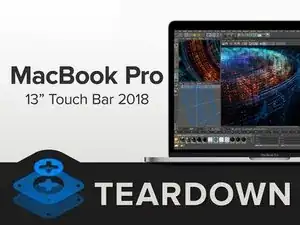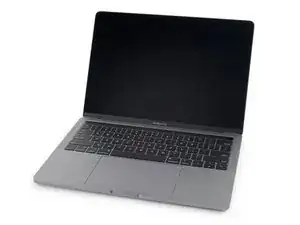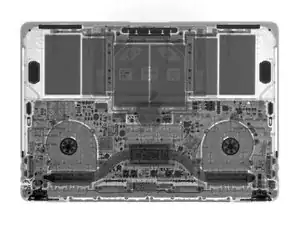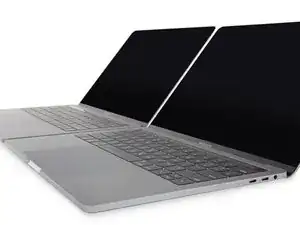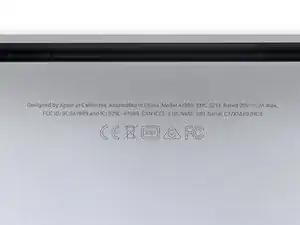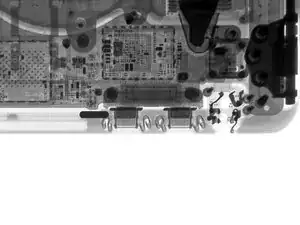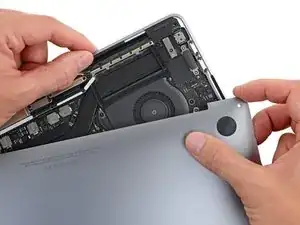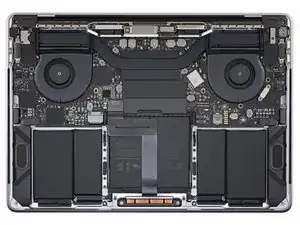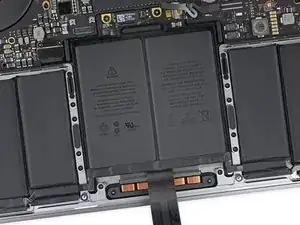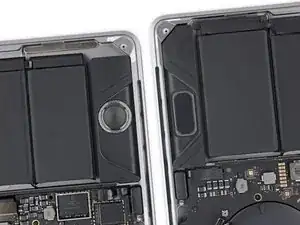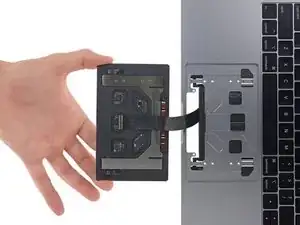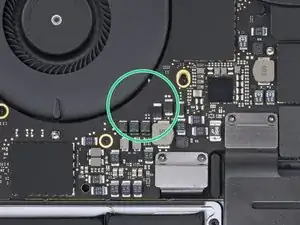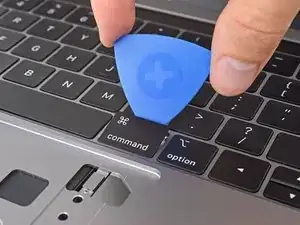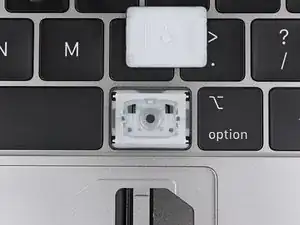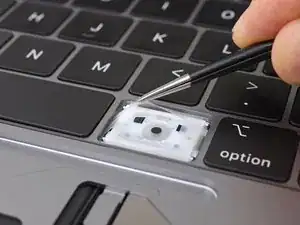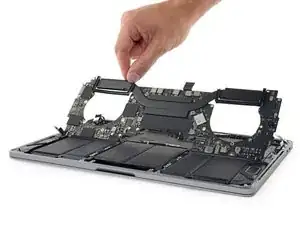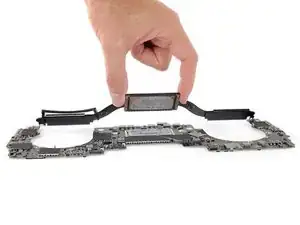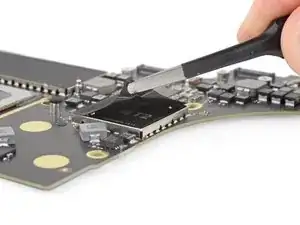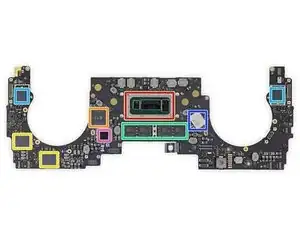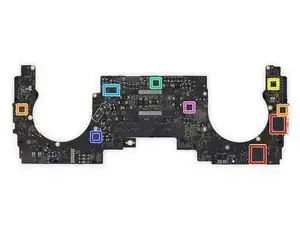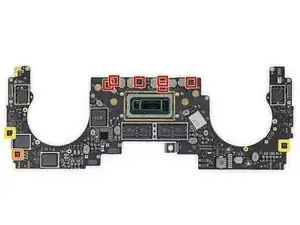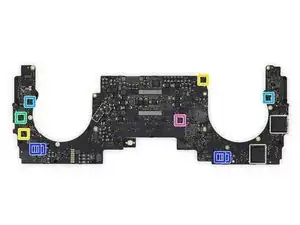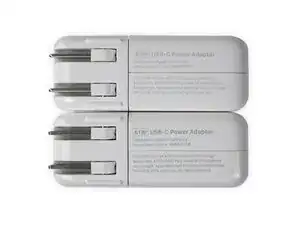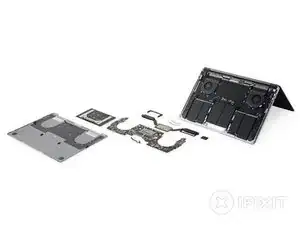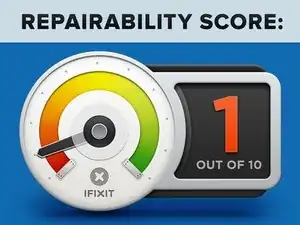Introduction
Apple has been quietly improving their pro-level laptops, making them … quieter. Turns out they’ve improved the clacky keyboards more than they’ve let on—which leaves us wondering, what else is new in here? All we need is a teardown team and several thousand US greenbacks to find out. Grab your best tinkering tools and let’s dig in—we’re tearing down the 13” MacBook Pro with Touch Bar, 2018 edition.
Looking for more device disassembly detective work? Follow us on Facebook, Instagram, and Twitter for all the latest teardown news.
Tools
-
-
Before we put this one under the knife, let's review what we exspec to find:
-
13.3" LED-backlit IPS Retina display with True Tone, 2560 x 1600 resolution (227 dpi), P3 wide color gamut
-
2.3 GHz quad-core Intel Core i5 (Turbo Boost up to 3.8 GHz) with integrated Intel Iris Plus Graphics 655
-
Apple T2 custom coprocessor
-
8 GB of 2133 MHz LPDDR3 SDRAM
-
256 GB PCIe-based SSD
-
802.11ac Wi-Fi and Bluetooth 5.0
-
Four Thunderbolt 3 (USB-C) ports supporting charging, DisplayPort, Thunderbolt, USB 3.1 Gen 2
-
-
-
Spoiler alert! As always, we like to start off with a superhero's-eye-view of our victim's internals.
-
These X-ray images come to you thanks to our ingenious pals at Creative Electron.
-
Don't worry, we're still going to take it apart. Hold that thought ...
-
-
-
We open up last year's 13" MacBook Pro with Touch Bar for a quick comparison—and if we were to judge a MacBook by its cover, we'd say these were the same machine.
-
Apple says this butterfly keyboard is a bit quieter, but otherwise unchanged. After banging away at the keys in a side-by-side sound-off, we definitely perceive a lower, less clacky tone, but any difference in decibels is difficult to detect.
-
The biggest change so far: a new model number—A1989, and EMC 3214.
-
X-rays also show the return of the modular headphone jack, and provide a peep at the Thunderbolt hardware—which now runs at full speed on all four ports, thanks in part to the 8th-gen Core processor's four additional PCIe lanes.
-
-
-
Our teardown begins in earnest—we dispatch a sextuplet of pentalobe screws, and dash through what by now is a pretty familiar opening procedure.
-
At first glance, the internals look very similar to the 13" MacBook Pro from last year ... and the year before that.
-
At second glance, we decide to go in closer for a third glance.
-
-
-
We disconnect the battery without any drama—it's buttoned down with a T5 Torx screw, so we use one of our blue and black Pro Tech specialty drivers to dispatch it.
-
At 58.0 Wh, this battery has gotten a significant boost over the 49.2 Wh unit we found in our original 13" Touch Bar teardown.
-
Turns out that extra 'oomph' comes from a slightly bigger battery—arrayed into six cells this time, instead of five. It's also heavier, weighing in at in at 232.7 g, versus the old battery's 196.7 g.
-
And yet this MacBook Pro's total weight hasn't changed one iota. We're not sure which parts of this device have been on a diet, but it does look like Apple shaved some mass off the top case.
-
The new-and-improved speakers (on the right) have grown, too—they're longer and narrower, filling all the remaining space, and bumping right up against the logic board thanks to the revised top case design.
-
-
-
In a lone piece of happy repair news: the trackpad is replaceable as ever. Twirl away a few Torx screws, and off it flies.
-
We get our first taste of some chips under the trackpad (looking virtually unchanged from their first outing back in 2016):
-
STMicroelectronics STM32F103VB ARM Cortex-M3 MCU
-
Broadcom BCM5976C1KUFBG Touch Controller
-
Maxim Integrated MAX11291ENX 24-Bit, 6-Channel Delta-Sigma ADC
-
Meanwhile, we can't help but notice the earlier model's port to nowhere—which turned out to be for data recovery—is mysteriously absent.
-
-
-
Apple was careful to mention its latest third-gen keyboard in its press release. The added quietness seems a bit underwhelming to our ears, and we suspect there's something more going on.
-
After three years of key-cap removal, we're able to pop this lid open without damaging the delicate clips, and boy are we rewarded.
-
As you may have heard, there's a brand new silicone barrier under here.
-
This bears further analysis. We'll have a deeper dive on the keyboard situation later in the week. Stay tuned!
-
-
-
Time to liberate that logic board and look around!
-
As usual, a relatively modest-looking heat sink handles cooling for the CPU and integrated graphics. Another par for the course: Apple's typical glut of thermal paste.
-
And our first peep of silicon reveals: the touted T2!
-
Seen previously in the iMac Pro, Apple's custom T2 chip has taken over an impressive number of functions—but, we still expect to find a lot of other silicon on this board. Let's check it out!
-
-
-
Here's a familiar mustache full of chips:
-
8th-generation Intel Core i5-8259U CPU with Intel Iris Plus Graphics 655
-
Apple T2 APL1027 339S00533 coprocessor, layered over 1 GB Micron MT53B256M32D1TG-062 XT:C LPDDR4
-
Toshiba TSB 3226 J86404 TWNA1 (likely 2x 64 GB flash memory, 128 GB total on this side)
-
4x SKhynix H9CCNNNBJTALAR-NVD 16 Gb LPDDR3 2133 MHz (8 GB total)
-
Intel JHL7540 Thunderbolt 3 Controller
-
Apple/Universal Scientific Industrial (USI) 339S00428 Wi-Fi/Bluetooth module
-
338S00267-A0 (likely Apple PMIC)
-
-
-
And we flip it around for some bonus silicon:
-
2x Toshiba TSB 3226 J86404 TWNA1 64 GB flash memory, for 128 GB on this side and 256 GB total)
-
2x Texas Instruments CD3215C00 83CFZST
-
Cirrus Logic CS42L83A Audio Codec
-
Intersil ISL95828AHRTZ PWM controller
-
2x NXP Semiconductor CBTL06142F display port multiplexer
-
Texas Instruments TPS51980A synchronous buck controller
-
NXP Semiconductor PN80V secure NFC module
-
-
-
IC Identifications, continued:
-
ON Semiconductor FDMF5808A, FDMF5804, and Vishay SIC532 power stage
-
Apple 338S00438 ? power management
-
Bosch Sensortec BMA282 accelerometer and Texas Instruments TMP464 5-Ch. remote/local temperature sensor
-
Diodes Incorporated PI3USB32 dual SPST USB 2.0 switch
-
Winbond W25Q80DV 8 Mb serial NOR flash memory
-
Texas Instruments TASxxxx audio amplifier
-
Texas Instruments TPS51916 DDR memory power management
-
-
-
And for our dessert course we have: a brand new USB-C power adapter!
-
The A/C adapter included with this 13" MacBook Pro does indeed sport the new model number A1947 (vs. A1718, bottom), so it's time to bust out the ultrasonic cutter and go to town.
-
After clawing painfully through more layers and rubberized filler than we've ever seen in one of these things, we finally free the internals.
-
Opening the previous adapter (on the left) was a walk in the park compared to this unit, but it does look like this model benefits from redesigned internals, some additional shielding, and lots of impact-resistant foam rubber.
-
That said, Apple has also swapped the aluminum USB-C port for a plastic one ...
-
-
-
Here's what's left after the 2018 MacBook Pro gave up its secrets, including:
-
A bigger battery that squeezed the speakers into a narrower form factor.
-
A keyboard decked out with a thin silicone barrier, which could be for sound baffling, but matches Apple ingress-proofing patents.
-
And a seemingly unchanged thermal management system, despite the extra power under the hood.
-
Teardown Update: we wanted to drill a bit deeper into the new keyboard, so we did some testing and then gave it another teardown all to itself. Check it out!
-
-
-
The 2018 MacBook Pro 13" with Touch Bar earns a 1 out of 10 on our repairability scale (10 is easiest to repair):
-
The trackpad can be removed without first removing the battery.
-
The processor, RAM, and flash memory are soldered to the logic board. Repairs and upgrades will be impractical at best.
-
The top case assembly, which includes the keyboard, battery, and speakers, is glued together—making all those components impractical to replace separately.
-
The Touch ID sensor doubles as the power switch, and is paired with the T2 chip on the logic board. Fixing a broken power switch may require help from Apple, or a new logic board.
-
51 comments
RAID 0 SSD? From Samsung?
Hi Peter,
The “SSD”/flash memory is made by Toshiba.
Not in this series.
Keep in mind the T2 is a flash controller, so Apple is side stepping the PCIe/NVMe issue of the SSD instead using raw flash chips which are interleaved simular to how memory is done. The T2 presents the PCIe/NVMe interface to rest of the system.
In truth it’s like RAID, but it’s not! It’s something newer! As it’s soldered to the logic board Apple can get away with this.
Dan -
To elaborate on what Dan said, the T2 chip includes Apple’s own NVMe PCIe SSD controller, which they developed in house. Like most SSD controllers, it uses multiple channels (maybe 8 in this case?) to address the NAND flash dies and increase performance through parallelism. Both the T2 and the NAND flash packages are soldered directly to the logic board. It is also likely that the drive can tolerate the failure of individual blocks and pages, or perhaps even whole NAND dies by using parity data.
This is a different concept than RAID though, which employs Redundant Arrays of Independent Drives to increase availability and in some cases performance. RAID 0 in particular ditches the redundant bit and stripes across an array of independent drives purely for increased performance. Apple decided to put the NAND flash packages for the iMac Pro on a pair of removable modules, however they were in no way independent drives. There was still only a single SSD controller located in the T2 chip on the logic board.
The T2 processor should not be NAND Flash controller here. T2 is more like a RAID controller. Refer to https://duo.com/blog/apple-imac-pro-and-... The Toshiba chip here could be a PCIe/NVMe SSD in BGA chip package(like the one in the iPhone/iPad). The physical interface between T2 and Toshiba chip could be PCIe interface. T2 processor is also used to replace TI’s SMC controller.
JJ Wu -
@JJ Wu, The SSD controller is in the T2. To quote Apple: “Introducing the Apple T2 chip, our second-generation custom Mac silicon. By redesigning and integrating several controllers found in other Mac systems — like the system management controller, image signal processor, audio controller, and SSD controller — T2 delivers new capabilities to the Mac.”
The notion that the iMac Pro used independent drives in RAID 0 is a widely held misconception that is entirely inaccurate. Look at the packages on the modules. They are commodity multi-chip NAND packages that connect to the SSD controller in the T2 using a typical NAND bus architecture. This is essentially the same SSD as in the iMac Pro but the NAND packages are on the logic board instead of on independent modules.
@repoman27 i talked to Apple store employee. The SSD module used in the Apple iMac Pro can be replaced by other PCIe SSD(Apple does not recommend doing that) and the employee said it is PCIe interface which means it can not be typical NAND interface.
This is an example of BGA SSD on M.2 module https://www.anandtech.com/show/12819/the...
JJ Wu -
@JJ Wu The SSD in the iMac, Mac Pro, MacBook Air, and MacBook Pro (Late 2013 - 2015) is a PCIe SSD with a proprietary form factor and connector. If you have installed macOS 10.13 High Sierra or later, the firmware will be updated to unofficially support 3rd party NVMe PCIe SSDs. Then you can use an adapter to physically convert from Apple’s proprietary interface to M.2 2280 or whatever and replace the drive. Third party solutions emulating Apple’s form factor and connector are also available for these models.
That is not at all the case for the *iMac Pro*. No adapter exists because the NAND flash modules are not independent drives and are not connected to the T2 via PCIe. Look at the iFixit teardown of the iMac Pro. Try searching for an adapter or third party SSD upgrade solution. You will not find one.
Data recovery from a failed logic board is probably handled by the T2 chip, since it serves as the flash controller. If the T2 chip is toasted, the contents of the flash memory are probably beyond recovery, since the T2 almost certainly uses a hardware key as part of the encryption scheme. No idea about how service techs would communicate with the T2 on an otherwise failed board. Maybe via an existing bus connector?
Intel JHL7540 Thunderbolt 3 Controller? The new Titan Ridge controller? Does that mean these MacBook Pros support DisplayPort 1.4?
Wow, new TB3 controller, really? Does that mean these 13-inch notebooks now have full-speed on all four TB3 ports?
That was already confirmed, yes. The new 13-inch MacBooks have full-speed on all four TB3 ports (as fas as I know, the previous generation didn’t not because of the controllers, but because the Intel CPU itself only had 12 PCIe lanes, which weren’t enough to have full-speed on all 4 ports). But I haven’t seen the DisplayPort 1.4 support mentioned anywhere, which is why I presumed that Apple didn’t update the controllers to the Titan Ridge generation.
Seems like it!
Sepand -
Ok, it seems I was too optimistic. According to Anandtech:
It's also worth noting that since the DP 1.4 spec is not supported by Intel's iGPUs, Intel-powered notebooks and desktops looking to take advantage of Titan Ridge's DP 1.4 functionality will have to use dGPUs to drive their TB3 controllers. This will somewhat increase the complexity of these designs, since previously most vendors only needed to route the iGPU to the TB3 controllers.
So it's certain that the 13-inch MacBook Pro does not actually support DisplayPort 1.4, because the integrated Intel GPU does not support it (and you cannot add a dGPU to the 13-inch MacBook Pro). As for the 15-inch MacBook Pro, it remains a possibility, but I don't think that Apple did in fact decide to use the dGPU to drive the Titan Ridge controller, which means that the 15-inch MacBook Pro doesn't support it either, I presume.
External displays are always driven by the discrete GPU on the 15-inch, so there is still hope there. I believe the internal display is connected to the Intel integrated GPU via eDP to allow graphics switching, but 4 DisplayPort main links from the AMD GPU feed the two Thunderbolt controllers.
